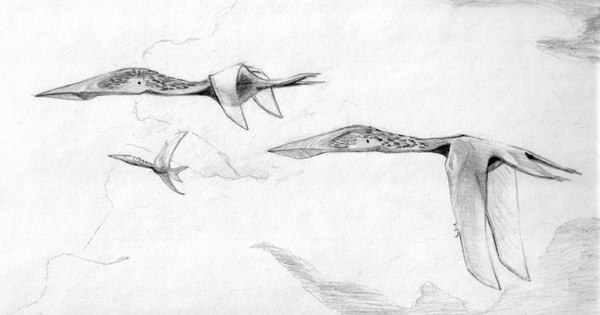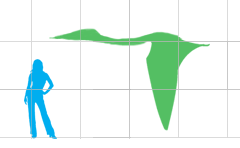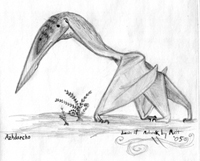home > natural history
Azhdarcho
lancicollis
"lance-necked dragon"

As
you can see, Azhdarcho (the Uzbek word for dragon) and its kin were some of the
most bizarre looking animals to ever walk the Earth. What immediately stands out is the
size of the head. It really is gigantic, and in some species the entire torso could fit
inside the antorbital fenestra! The neck of azhdarchs was just as disproportionate, and it
seems as though an animal so front heavy could never fly. In fact, since pterosaur bones
were paper-thin the whole creature probably weighed only a few pounds, and might have been
as delicate as a butterfly. In pterosaurs with relatively massive skulls, like the the
azhdarch Hatzegopteryx, even the bone itself had a highly specialized structure
similar to styrofoam, allowing it to be both sturdy and incredibly light weight. It's no
wonder that these flying animals could grow to such enormous sizes, up to 80ft in wingspan
for some species. Azhdarcho would have only needed a light breeze to lift its
possibly 15 foot wingspan into the air, but getting around on the ground was a different
story.
There's long been a debate over just how pterosaurs walked, but
pterosaur footprints have shed light on the subject. Azhdarcho would have walked on
all fours with its hind feet plantigrade (walking on the heel as humans do), and with its
front feet pointed out and backwards, allowing the long wing-supporting finger to fold
against the arm like a switchblade. There's still a debate over how the trailing edge of
the wing attached to the body. Old restorations show the wing attaching at the lower leg,
with the legs aiding bat-like in flapping. Others show the wing attaching to the upper leg
or even tail. I've restored it attaching to the femur, with a dynamic hind wing apparatus
formed from the legs and uropatagium (after Cunningham). The attachment point of the
trailing edge also leads to debate over the overall wing shape, a very important factor
when trying to figure out how these creatures flew. Pterosaurologists have traditionally
fallen into broad-wing and narrow-wing camps. However, new studies of the mysterious
fibrous structures that make up the wing membrane (called actinofibrils), and the brains
of pterosaurs, add a new twist. It seems that actinofibrils are actually highly
specialized muscle fibers that radiate throughout the wing membrane. Studies of the
pterosaur brain show a tremendous amount of volume in the areas devoted to fine muscle
control. These factors make it seem likely that the pterosaur wing was not a static
surface bound to a wide or narrow shape, but an incredibly dynamic muscle complex capable
of subtle and dramatic changes in shape and tension.
Also note Azhdarcho's coat of ptero-fuzz, a form of insulation that was very soft and hair-like. Ptero-fuzz may be homologous with dino-fuzz and bird feathers, but this seems unlikely. Impressions from pterodactyloids like azhdarchs typically show a longer 'mane' of ptero-fuzz on the neck, which may have helped make these animals more aerodynamic. The presence of insulatory skin coverings and the continuing discoveries that support pterosaurs as highly active fliers are enough to convince a vast majority of paleontologists that these reptiles were warm blooded.
Pterosaurs, like dinosaurs and crocodiles, belong to the reptile group Archosauromorpha. Long thought to be close relatives of dinosaurs, it is also possible that they belong to the more primitive Prolacertiformes, a strange group including the superficially chameleon-like drepanosaurs and the extremely long-necked tanystropheids. Azhdarchidae is classified within the sub-group of pterosaurs known as Pterodactyloidea. All azhdarchs were toothless, and they may have inahbitated mainly inland, terrestrial niches similar to modern storks, nabbing small vertebrates with their spear-like jaws (hence Azhdarcho's specific name, lancicollis, meaning "lance-neck"). Azhdarcho itself was discovered by Nessov in 1982 in Uzbekistan (you can read the original description by clicking the reference below), and lived from the Turonian to the Coniacian age of the Late Cretaceous.
For more on Azhdarcho, see the Wikipedia article I helped edit.
References:
Astibia, H., Buffetaut, E., Buscalioni, A.D., Cappetta, H., Corrall, C., Estes, R., Garcia-Garmilla, F., Jaeger, J.J., Jimenez-Fuentes, E., Loeuff, J., Mazin, J.M., Orue-Etxebarria, X., Pereda-Suberbiola, J., Powell, J.E., Rage, J.C., Rodriguez-Lazaro, J., Sanz, J.L., and Tong, H. (1991) "The fossil vertebrates from Lafio (Basque Country, Spain); new evidence on the composition and affinities of the Late Cretaceous continental fauna of Europe." Terra Nova, 2: 460-466.
Bennett, S.C. (2000). "Pterosaur flight: the role of actinofibrils in wing function." Historical Biology, 14: 255-284
Nessov, L.A. (1990) [Flying reptiles of the Jurassic and Cretaceous of the
USSR and the significance of their remains for the
reconstruction of palaeogeographic conditions]. Bulletin
of Leningrad University, Series 7, Geology and Geography, 1990,
4 (28), 3-10 [In Russian].
Nessov, L.A. (1991) [Giant flying reptiles of the family Azhdarchidae: 11.
Environment, sedirnentological conditions and
preservation of remains]. Bulletin of Leningrad
Universitv Series 7, Geology and Geography,1991, 3 (21), 16-24 [In
Russian].
Image Details:
Media: Graphite
License:
ALL RIGHTS RESERVED
DESCRIPTION
Length: 3m (9ft)
Wingspan: 4.5m (15ft)
Weight: 100kg (220lbs)
Location: Bissekty Formation, Uzbekistan
Time: Turonian stage, late Cretaceous period (90ma)
CLASSIFICATION
Kingdom: Animalia
Phylum: Chordata
Class: Stem-Aves
Order: Pterosauria
Family: Azhdarchidae
Genus: Azhdarcho
Species: A. lancicollis
SYSTEMATICS
Sauropsida
Diapsida
Archosauria
Ornithosuchia
Pterosauria
Azhdarchoidea
Azhdarchidae

